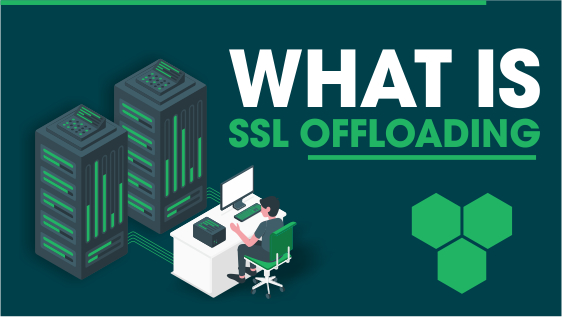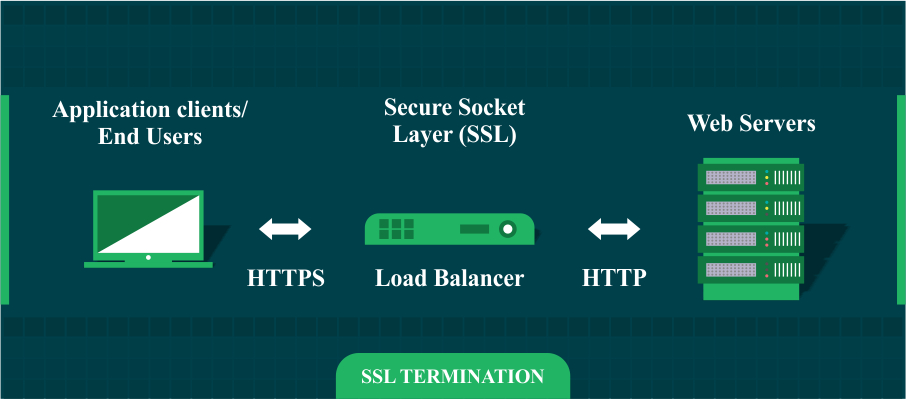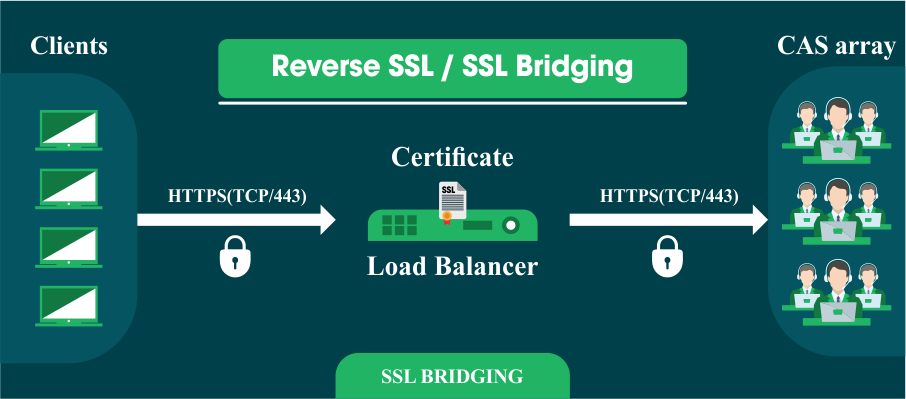If you are a regular internet surfer, you must have noticed that some sites get slower when many users visit the same. For example, when there is a popular football match, or entertainment sites when an episode of a popular serial is aired, etc. Another reason for the slowing down of servers is SSL certificates responsible for the website’s security. You cannot remove them, but you can accelerate the speed of your server using SSL offloading.
What is SSL Offloading?
An SSL offloading is the mechanism of transferring the incoming encrypted traffic from a client to a load balancer to relieve the webserver from encryption/decryption of data. A load balancer is positioned between a browser and the webserver. They use SSL security protocol to perform either SSL termination or SSL bridging to lower the server’s metaphoric shoulders’ operational.
The load balancer receives the encrypted data coming from a. It performs decryption and sends the plain text to the server, making it free from this time-consuming process.
Here is the list of famous SSL load balancer providers:
- HAProxy
- Nginx
- Kemp
- Cloudflare
- F5
- Manage Engine
- loadbalancer.org
How is a Regular SSL connection Made Without SSL Offloading?
At this stage, you have made an impression of SSL offloading in your mind. You might be wondering why SSL offloading is needed. To understand that, you must know how a systematic SSL connection works:
- When a user visits a site with a valid SSL certificate, the browser and the webserver start an SSL handshake.
- In the first step of the SSL handshake, the browser checks for the server’s authenticity by examining its SSL certificate, making sure that a trusted third party issues it.
- An SSL license has two keys- a public key and a private key. These keys are used for encryption and decryption of information for secure communication during an SSL handshake.
- After checking the SSL certificate’s validity, the webserver and the browser create a third key called a session key.
- By doing so, a safe connection is built between the two parties. A session key is then used for communication between the two parties.
Why Need SSL Offloading?
As you already know, a public key and a private key are used to encrypt and decrypt. These keys are of larger size (2048-bit) with the RSA algorithm. Although it safeguards the site completely, it makes the encryption and decryption process slow due to its bulky size.
A session key is faster than 2048-bit keys, but when many visitors land on the same website, the server has to deal with many session keys. This burdens the server with encryption or decryption requests in a short interval of time.
This activity is CPU-intensive and consumes the resources of the web server up to a large extent. This process makes the server work slowly. the SSL offloading concept was introduced to make the backend work faster.
How Does SSL Offloading Work?
A load balancer is used for the task of SSL offloading. The load balancer is positioned between the browser and the webserver to perform the chore in place of the server. The load balancer uses the same SSL certificate that is already issued to the server to complete this task. A load balancer can perform this job in two different ways.
1. SSL Termination
2. SSL bridging
Let us find out the working, pros, and cons of both methods separately:
#1. SSL Termination
SSL termination is an SSL offloading that helps in accelerating the speed of the server. This process is done by connecting the user through a secured connection to the load balancer and then connecting them from the load balancer to the server via an insecure connection.
The information shared between the user, and the load balancer remains secure while exchanging information between the web server and the load balancer is unencrypted. The working of SSL termination is explained below:
- A load balancer is placed between the server and the client’s browser.
- When the client requests an HTTPS connection, a session key is created between the load balancer and the browser using the server’s public and private keys.
- All the information that is encrypted by the client’s browser reaches the load balancer.
- The load balancer decrypts this information using a session key and sends the unencrypted information to the server.
- The server receives the data in unencrypted form, so it does not need to decrypt it.
- The response by the server is sent in plain text to the load balancer.
- It performs encryption on this data using the session key.
- The browser receives data from the load balancer and uses the session key for decryption.
Advantages of SSL Termination
- The encryption and decryption of the incoming data are done through a load balancer. So, the server is free of workload.
- SSL termination is best for websites that do not deal with the customers’ sensitive data (username, password, bank details).
- It helps in accelerating the speed of the server.
Disadvantages of SSL Termination
- The data between the load balancer and the server is transmitted in plain text, which makes it easy for hackers to steal sensitive information. In a way, it violates the purpose of having an SSL certificate because of the secrecy of the data is compromised.
- The server shares its keys to the load balancer which may lead to vulnerabilities.
- It deceives the clients that their data is safe and secure throughout the communication, although encryption is lost mid-way and they do not know about this.
- As the load balancer handles all the data, it isn’t easy to trust that all the information is still secure.
#2. SSL Bridging
SSL bridging is another method of SSL offloading. It is not appropriate for the websites that use sensitive information of the clients’ such as usernames, passwords, or banking details, etc., to use the SSL termination technique. Handling a large quantity of HTTPS data from the users makes these web servers work slower. For this purpose, SSL bridging is used by these websites. Like SSL termination, a load balancer is used in this technique too. But the way of working is different, which is explained ahead:
- A user sends the data through an HTTPS connection to the load balancer.
- The load balancer receives the encrypted data and performs an SSL inspection on this information.
- If the load balancer finds anything suspicious in the HTTPS data, it blocks that content.
- Then, the load balancer again encrypts the data and sends it to the server. So, the data remains safe throughout the process.
- The server then decrypts the information and sends the encrypted response to the load balancer, which is then forwarded to the client.
Advantages of SSL Bridging
1. The main advantage of SSL bridging is that data security is not compromised. The information stays encrypted in the whole process.
2. It protects the server from the following web-application attacks:
- SQL Injections
- Distributed Denial of Services
Disadvantages of SSL Bridging
- The server still performs encryption and decryption itself. So, this workload is not reduced.
- The biggest disadvantage of this method is that all the command is given to the load balancer to inquire about the data’s security. If somehow, the AI system of load balancer does not work properly, then there is a chance of important or safe data being blocked too.
Conclusion
SSL offloading makes your server work fast without latency. This can go a long way in helping you get a leg up on your competitors. As if your site takes time in loading, then the visitor will surely leave your website and will go to the next one.
So, by using the SSL offloading technique, you can achieve success in your online business. After reading the pros and cons of both techniques’ you must have got an idea which technique you should use for your website as a single load balancer can perform only one task at a time, either SSL termination or SSL bridging.
It would help if you chose the load balancer providers wisely as you have to share your web server’s private key with them.
Related Post:



